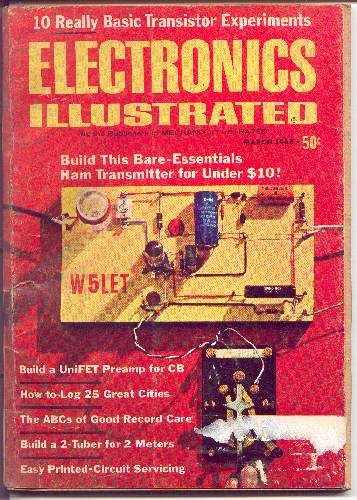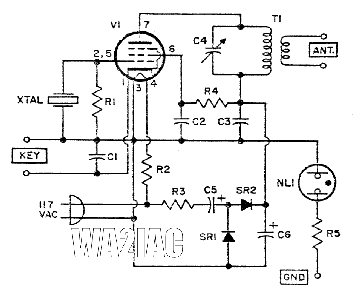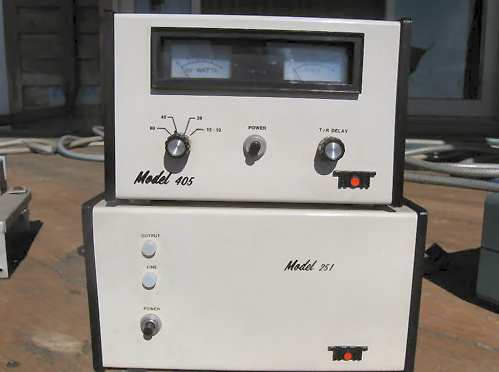WA2IAC
[Home] [New! Blog] [New: 2011] [Gear] [Docs] [QRZ.COM me] [Site Map]WA2IAC in 2011
July
My time has been eaten up by changes on the work front. With unemployment slacking, and especially increasing here, I'm thankful for being busy.
To enable me to continue to post new material regularly on this site without spending as much time doing it, I've lamely set up a Wordpress blog on this website the posting of "new" and "news stream" material will be focused there, although at this time I expect to continue to post (or perhaps just archive) chronological information in this section of the website. We'll see how that works out.
Visit the new WA2IAC Blog
April through June
Not much activity during this time. I've been operating mostly via the BARC (Boulder Amateur Radio Club) remote radio at the Boulder Municipal Airport. Most of that operation has been on 75 meters, either AM (the locals operate around 3875) or on a few SSB nets I check into. I also occasionally check into the circus known as the Colorado High Noon Net on 40 meter SSB.
Coming soon from this era:
- Pictures from LARC Fest
- Pictures from BARC Field Day!
On Field Day, I participated with the BARC setup at the Betasso Preserve, a beautiful spot. I participated in a mostly failed attempt to work some satellite stations, and also exercised my rusty CW on 20 and 40 meters in the dead of night. I slept overnight in my Jeep truck-tent, since Boulder County forbids camping anywhere except in a dusty parking lot in Longmont.
Look for new material to appear first in the new blog, and then here in more expanded form.
(this section updated 7/15)
March
Remote Operation at BARC
In addition to using the WA6LIE remote (see below), I've gained access to the BARC remote HF system, allowing me to get on 80 through 10 meters, and also the AM mode. This has really helped in dealing with the restrictions of operating out of an apartment. I even made contact with my old friend Timtron, WA1HLR, back East in Maine with just 40 watts of AM to the dipole, in the comfort of headset-to-PC at the apartment. Just in time too, I had to take the apartment antenna down due to windstorms in the Foothills with gusts up to 65 miles per hour!
Thanks to the BARC remote base, I'll be operating on all the bands 80-10 at one time or another, reducing my dependency on the 20 meter band, but also making me more scarce there. The BARC remote base also supports CW mode, and I'll be spending some time modifying the AA0ZZ keyer to use this capability. Thanks to Boulder Amateur Radio Club (BARC) for helping me out!
Activating the HTX-10 10-Meter Mobile Transceiver
10 Meters is heating up! It was time to take the Rad Shaft HTX-10 10-Meter Korean made cheapie SSB transceiver out of storage where it had languished since the last solar maximum. During sunspot cycle peaks, working DX with the HTX-10's 25 watts of SSB is like shooting fish in a barrel. You can't beat it for the price, which takes some of the stress out of leaving it in the car (since visiting Colorado, my Jeep has been broken into 3 times by either clueless homeless, or drug addicts). You can find these rigs on eBay for around $99, although that may go up as people start to figure out that they have value during the solar maximum...
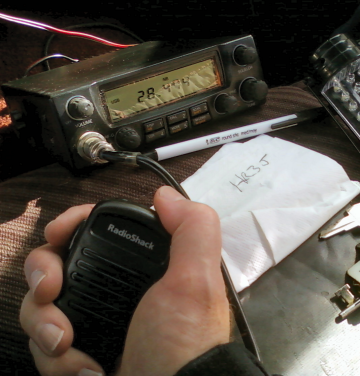
The HTX-10 is an inexpensive transceiver that covers most of the 10-Meter band and supports SSB, FM and AM modes. It requires a maximum of 5 amps, which is below the 7 amp maximum for properly installed cigarette lighter recepticles. This allows for easy temporary mounting of the HTX-10 in combination with a mag-mount CB antenna, available cheaply and readily from Radial Shaft. For detailed information on the rig, see the HTX-10 page. The photo above shows the rig sitting freely atop the transmission hump, and resting on the bench seat in the Jeep. At the photo, upper right, the coax feedline from the mag-mount antenna snakes in through the back window, and around the seat to get to the rig without getting in the way. The stock cable that comes with the antenna is completely adequate. A heavy-duty cigarette lighter plug (photo, right) also from Radial Shaft is fused and has both compression screw bindings as well as accepting bananna jacks, should you want or need that. The whole thing takes about a minute to set up or break down. I calculated the length for the desired center frequency of the antenna, cut it slightly longer, and then trimmed and tested with my MFJ-269 antenna analyzer until the center frequency was obtained. Other measurement techniques like an SWR meter can be used, of course. Be sure to make measurements with the antenna mounted in the desired spot, and with the feedline in operating position to get results as close to reality as possible. |
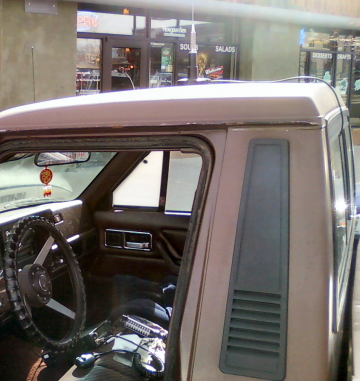 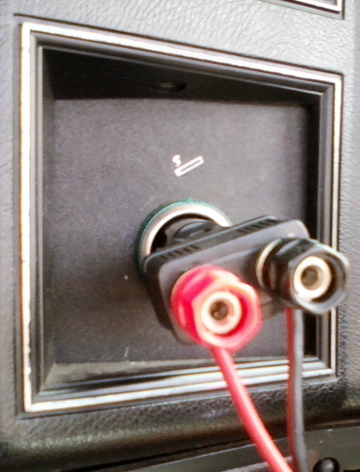
|
Portable Base Setup
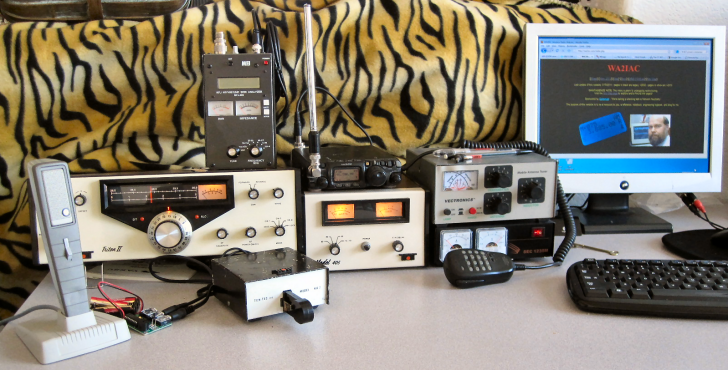
Above: the portable shack in Boulder as of 3/18/2011 - Below: AA0ZZ Keyer Kit allows for comfy CW operation.
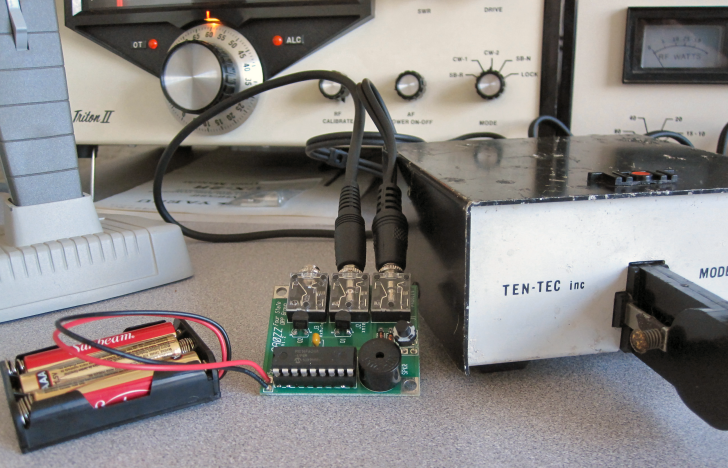
After acquiring the Triton II, I was a bit frustrated by not having a functioing key. The only key device on hand was my ancient Ten Tec KR-2 paddle, which used to control a tube keyer that is now stolen property. I could use it with the built-in keyer on the FT-817 without problem, but I had nothing to key the Triton II (and didn't want to use the KR-2 in "cootie" mode). I purchased a Ten Tec KR-40 squeeze keyer on E-Bay, but the seller packed it by just throwing it into a box of styrofoam noodles, and the paddle mechanism was damaged in shipping. I decided to build the AA0ZZ keyer, which was a very quick build. With the addition of a battery pack and two cables, I was able to finally get on the air on CW with the Triton II! The result is shown above. I'm still debating if I should put the keyer in the Altoids tin for which it was designed, a more aesthetic package, or put it in the KR-2 cabinet.
My Current Activity
I'm on 10, 15, 20, perhaps 40, and inbetween as antenna progress progresses. I'll be around the QRP frequencies on CW and SSB. I can also be found on VHF/UHF, and that might include some SSB on top of FM as there seems to be people to talk to on SSB in the areas where I am visiting. The image above represents the operating setup I'm using now. The antenna is Vern W6MMA's MP1. I'm also using a scraggly 10M dipole I've been carrying around with me. I'm dissapointed that I haven't heard any 10M openings (yet).
Internet Remote Station Use
Since I am in a temporary apartment setting, I am extremely limited in what I can do in terms of an antenna, or any kind of permanent shack. I can't even have a permanent feedline. The feedline comes in through a door that cannot be completely closed when the feedline is present, so the feedline has to be packed away when the station is not active. At times, the antenna needs to be completely put away.
As a result of this limitation, and not to be deterred from operating, I have been using Scott, WA6LIE's K3 in Salinas, CA remotely. This has been an interesting experience, because I haven't operated in California before. The view of the bands from there is different, and doesn't resemble the activity on the East Coast, as I had thought it might. For example, the carriers of my pals on 75 can be heard weakly at night as there is no activity on 3.885 on the left coast. 40 meter SSB is weird to me, with the absense of the "ECARS" "all day every day" net that guarantees a contact during the day, and something vaguely interesting to listen to. I started out on 20m at WA6LIE, but am now starting to explore 40M and 80M SSB. CW and AM modes are not available.
Another station I will soon be using is the BARC (Boulder Amateur Radio Club) system. It's an awesome system, but there are privacy concerns which I fully support based on my experience with gear thievage. So, if you'd like to find out more you'll need to talk to me on air. I'll give some clues about my activity on this page.
February
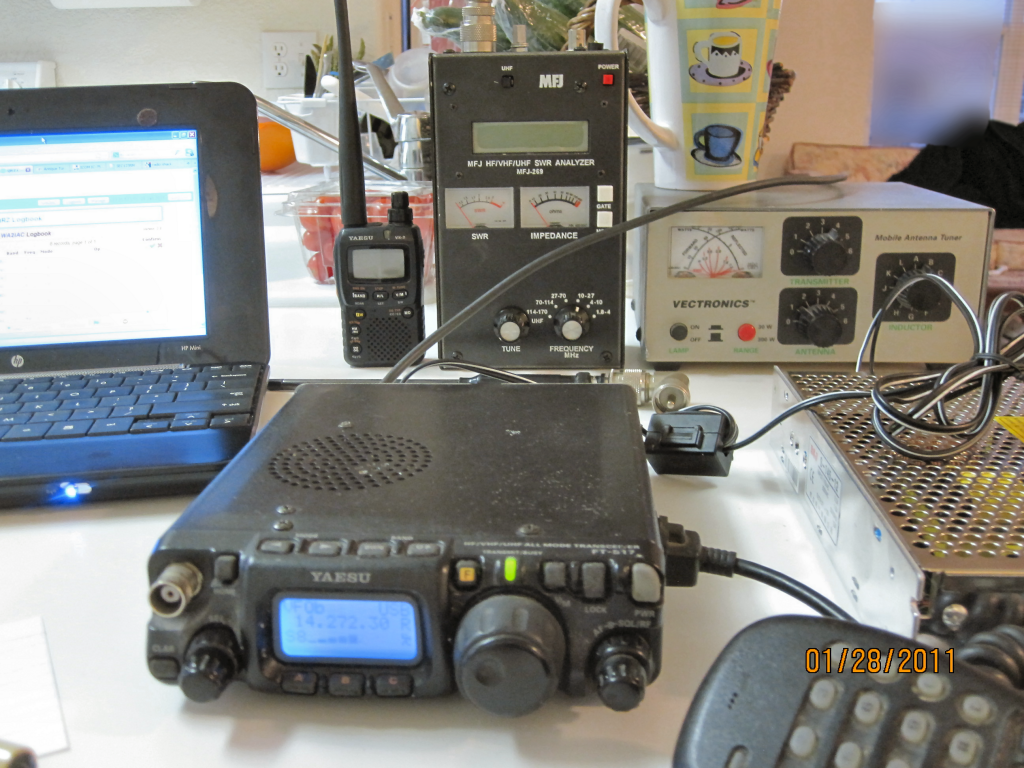

Click on the images above to see them in glorious high resolution. (L) Kitchen Shack (R) Mountain Topping at ~13,000 feet 10/4/2010
A Slightly More Permanent Setup with the Triton II and FT817
(2/12/2011) Below is pictured a slightly more permanent setup, which I can have for a few days at a time without prevailing on my hostess too much. I'm thinking of joining the BARC (Boulder Amateur Radio Club) and using their remote controlled HF station to get more operating in, and limiting my "home shack" to this QRP setup. Well, the Triton II is 200w, but you get the idea. Minimalistic shack at home! Note the vintage Electrovoice Hi-Z Dynamic mic, from the same era as the Ten Tec stuff. Also note the paucity of controls on the Triton II. As is said today: "W00t!", or "awesome"!
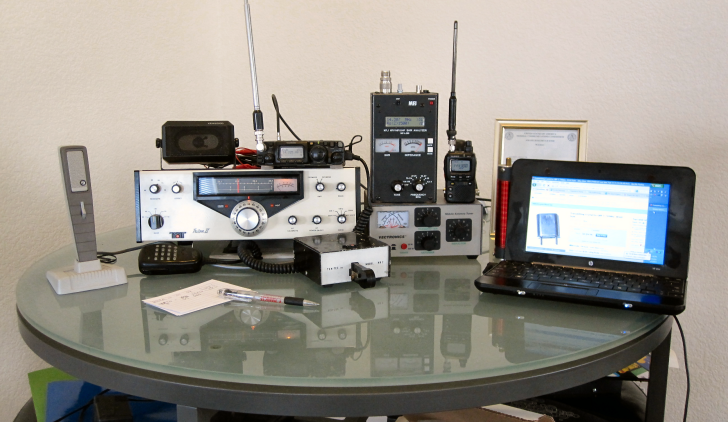 The shack as of February 12, 2011 - slightly less temporary
The shack as of February 12, 2011 - slightly less temporary
January
Back on HF! Travelling Lightish...
(1/20/2011) I'm back on HF! Albeit, QRP. As you can probably tell, I do not have a permanent shack. I am truly operating portable, and must set up my gear each time I need to get on the air.

click on the image above to see it in glorious high resolution (1/11/2011)
The image above, from left-to-right, depicts:
- HP Mini 1000 w/ solid state drive S/N CNU90904BH
- Rad Shaft 22-502 12v Power Supply
- Yaesu FT-817 S/N 0M050285
- Yeasu VX2R S/N 4D160594
- Vectronics VEC-645 POS antennema tuner
- Ten Tec KR2 Paddle
- Nokia speaker
- MP1 vertical antennema (usually tuned by an MFJ-269 so no antenna tuner is required)
- MFJ-269 "SWR Analyzer" - crucial to getting performance from QRP gear. I avoid using an antenna tuner when possible. Additionally, the frequency counter mode is useful in conjunction with the gear with analog tuning.
- Yaesu VX2R - for local repeater work
- Rad Shaft HTX-212 S/N 0129293 2m FM rig for use atop the refridgerator; awaiting a power supply for that
- Rad Shaft HTX-10 S/N 2000243 10M SSB transceiver (the raison de etre for the 10M dipole)
Logging to QRZ.COM
I've started using the QRZ.COM logging function, so if I work you, you'll see it there. I'll confirm log entries there as well. I'm working to keep my QRZ.COM page up-to-date. As Ham Radio seems to continue to dwindle, I've also rejoined ARRL, so my callsign at ARRL.net will work now.
I tried using ARRL's LOTW (Log of the World), but it was down, seemed overly clunky, and contesty. I'll try it again someday soon, but the QRZ implementation is fun and works, although it has its bugs (like propagating stale info about me). I know there are QRZ.COM haters out there. At this point I'm not sure what that's all about.
All of the logging systems and related things like eQSL.com seem to be obsessed with data verification (e.g. against the F.C.C. Database) and are thus unable to handle an operation like mine, which is on wheels; that is; moving around frequently. I guess we hams can't be trusted to make simple entries like "location", and "grid square". The most pathetic example of this is ARRL's LOTW. Standing on my head and spitting nickels into a bucket 15 feet away would be easier, not to mention that doing it in multiple locations at overlapping times would be FAR easier. This is not an issue of certificates, trustedness of verification compliance, or other forms of obsequiosity to authority. It's about simple user interface and data structure design. Comon, guys, get real. It's as if these systems were not designed by hams who actually go out into the world and use their radios in real life.
Hardware Experimentation
For business reasons, I'm diving back into the world of microcontrollers that I've been in on and off since around 1974 when I started working with the Fairchild F8, which came out slightly before the Intel 8008. As some of you may know, this was inspirational and led me to go on to design the development tools for the CP1600 first 16bit microprocessor, and later collaborate on the architecture for the 65816. Again, for business reasons, my first forays will be into the world of PIC due to its widespread use. However, I will shortly after be developing with the Parallax "Propeller" multi-CPU chip, which is intriguing; a far cry from the Parallax BASIC Stamp of years ago. The Propeller eliminates the need for coding a micro RTOS (Real Time Operating System) for an application as would be the case for a more Von Neumann-like single CPU, single accumulator, architecture.
I have a backlog of kits to build! These will be documented elsewhere on this site, so as time marches on, links will appear in the list below. My hostess is from another planetary system, and wishes to be anonymous, however, I am very grateful to her for making in possible to persue my primitive work in electronics. The kits include:
- Small Wonder Labs 20M PSK QRP rig
- 80M Warbler (Small Wonder Labs) 80M PSK Kit
- Emtech ZM-2 QRP Antenna Tuner
- Kanga FOXX-3 (no longer available!) 20M QRP CW transceiver
- Vectronics VEC-422K SCA Decoder (now obsolete; wonder if I'll receive anything...)
- LDG Automatic Antenna Tuner (although I don't really want this anymore, unless I can put it in a weatherproof container at the far end of the coax...)
I'm seriously considering building the "K8IQY Magic Box" kit. It's very cheap and makes a nice glue piece for experimenting with QRP receivers and transmitters so they can be used in actual practice as they come and go from my operating position. Somehow, the idea of putting it into a Ten Tec project box (yes, they still make those) as K8IQY intended warms the cockles of my heart...
Web Hosting Web Site Fixes
I'll be updating this site once a week or more for the next month or so until I get it straightened out. It went through so many re-hostings that much of the content is inaccessable. Since there are links into this website from many other sites, I will attempt to bring it back to full operating order without breaking too many things.
Why advertising? Like many people, I don't have money like I used to. The advertising helps subsidize the cost of the site, but not completely. I still pay out-of-pocket for the costs associated with this site, even if it is riding on the coat-tails of InfoWeb.net.
Cached Content and Updates
I will be sucking in content that refers to WA2IAC or this site and including caches of it on this site. The Internet changes rapidly, so information can be lost. I will begin to include copies of what is relevant to this site as local content. Check the list I'm working on, and email suggestions to my callsign at arrl.net.
I will be including more online copies of manuals for rigs I own. Some of these can be tough to find. For example, I had to get a paper copy of the manual for the Ten Tec Triton II as it was impossible to find online.
Revisiting W5LET's Bare Essentials Transmitter
I'm going to completely re-create the W5LET Bare Essentials 80m CW transmitter article here. With expanded material. I will also be re-creating the one that I built as accurately as possible (including all crudeness). You can find the beginnings of this work in the hardware section of this site. The rig is a one-tube (50C5 beam power pentode) CW only transmitter that runs right off the power line (no transformer!). It is truly bare-bones!
Read the article!
Hardware Acquisitions
New arrival: Ten Tec Triton II
A Ten Tec Triton II HF transceiver Serial #00502 has arrived which will complement my Ten Tec paddle, LOL. Condition: Excellent, from non-smoking environment. It will hopefully allow me to run a bit more than QRP power while I'm on the road. For detailed information about this rig, please visit the Triton II Gear Page.
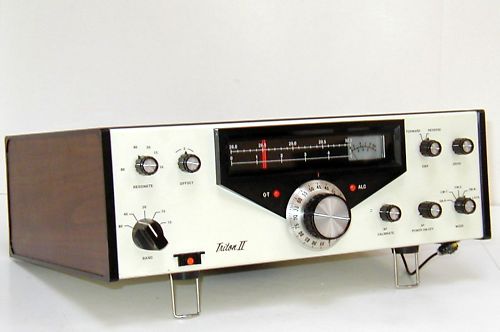
Ten Tec Triton II
Another New Arrival: Ten Tec Analog Century 21 (Model 570)
Obtained unit serial number 570-1954 from WN0ARD on 2/13/2011. Condition: pristine, from non-smoking environment. If you're unfamiliar, this is a CW-only transceiver for 80, 40, 20, 15, and 10 meters. The factory units were provided without the crystals for 15 and 10 because they cost a measely $5 a piece at the time. The crystal calibrator unit is necessary to ensure in-band operation. Although the VFO dial is linear, it's easy to be off as much as 5 KHz. I receiver the unit with the crystal calibrator, and the PTO/vernier had been rebuilt in the not too distant past. The image below is stock image; what I received is actually in better condition. I'll update with actual pictures soon. See the page for the transceiver here.
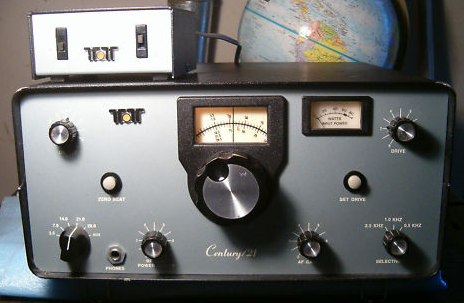
Ten Tec Century 21 with Model 276 Crystal Calibrator (Stock Image)
A Pal for My FT817... Ten Tec 405 QRP Linear
This was an oddity I decided to play with, definitely in the collector category, and brought me to the limit of equipment I can have at present. Acquired on 2/27/2011 in excellent condition, with evidence of exposure to some smoke (or maybe just age). This little amp is designed to step up RF power from QRP strength by an S unit or so at the receiving end. It's done up in the "yellow" design style of early Ten Tecs.
Yet Another New Arrival: Triton IV
In what is hopefully the end of a mini-acquisition spree, on 2/27/2011 I acquired a Ten Tec Triton IV with Remote VFO Model 242. Condition: Very Good, from smoking environment, thus requiring extensive cleanup. I got this because I've been enjoying using and exploring the innards of the Triton II that I acquired at random earlier. This rig is essentially an improved version of the Triton II. What really makes this an outstanding setup is the Remote VFO. You can switch any which way between the main and remote VFO, but beyond that, you can listen to two frequences at the same time and tune independently! A rare and valuable feature. You can fake that kind of operating with a dual digital VFO and a good memory of what's where, but it's certainly not as much fun. Along with these came the matching 252G power supply. The units are styled in a grey color, not the Ten Tec yellow... well, nothing's perfect from a collector's viewpoint, right? (pictures are as-received)
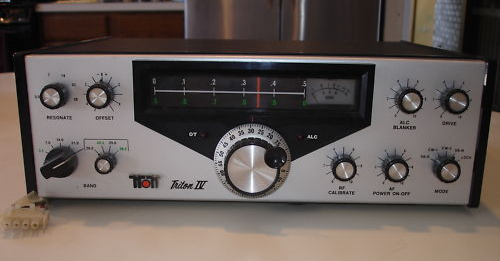
Ten Tec Triton IV
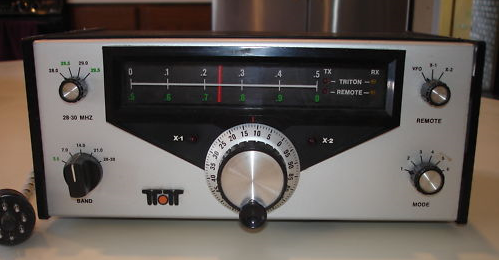
Triton IV Remote VFO Model 242
What Am I Doing Collecting?
Well, I'm having some fun -- aside from being nuts. But I can't keep all this stuff. So some of it will have to be sold. The Century 21 with matching antenna tuner and crystal calibrator will definitely go at some point. And, I'll sell either the Triton II or IV (but not both) at some point as well. As for the 405 amp, I'll see how much I use it with the FT817 and decide then. If you're interested in purchasing any of the Ten Tec equipment you see here, email me: my callsign @arrl.net.
73! And don't forget to explore this site, there's a lot here. Take a look at the Pseudo Site Map.
Design ©2002-2011, InfoWeb.net Content ©1971-2011 WA2IAC
